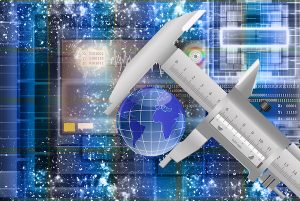Not to be confused with meteorology, metrology is the science of measurement. It establishes a common understanding of units, which is crucial in linking human activities. Interesting fact – modern metrology has its roots in the French Revolution’s political motivation to standardize units in France when a length standard taken from a natural source was proposed. This, in turn, led to the creation of the decimal-based metric system that was established in 1795. The decimal-based metric system helped to establish a set of standards for other types of measurements as well.
3D metrology is a growing field, but first it’s important to know how it is applied in other fields. It is divided into three basic overlapping activities.
Legal Metrology is concerned with the measurements that influence economic transactions; legal metrology is a very refined type of metrology. This field does not use physical tools as the other fields of metrology use. Instead legal metrology focuses on the buying and selling of materials for economic studies. Also, legal metrology can also be used for law enforcement fields.
Scientific Metrology deals with the organization and development of measurement standards, and their maintenance. It is deeply involved with new research and new technologies for industries concerning government, healthcare, and research for commercial products.
Industrial Metrology’s purpose is to ensure that instruments that are widely used in a variety of industries are all functioning properly. One example where industrial metrology is seen is in the manufacturing of products for the commercial industry, the testing of aircraft, the functioning of large machinery, or even in factories using rotating equipment during the manufacturing of their products.
Now, metrology is being applied to the field of 3D in terms of measuring size, volume and depth. When working with objects it is important to have precise measurements of their size for numerous reasons. A very integral part of 3D metrology is the ability to have measurement data that helps the production of manufacturable products.
3D metrology is typically conducted with the use of CMM technology, machine vision systems, hand tools, scanners, optical comparators and laser trackers. CMM technology refers to coordinate measuring machines. A CMM is typically done with a touch probe, scanning contact probe, or non-contact sensor. Machine vision (MV) is the technology and methods used to provide imaging-based automatic inspection and analysis for applications such as automatic inspection, process control, and robot guidance – typically used in an industrial setting.
Accuracy and precision are of the utmost importance within the field of 3D metrology. Accurate data for 3D models leads to higher repeatability, which in turn leads to a future of automation and scaling up of technology for the manufacturing environment.
It goes without saying that the cameras, and hence the lenses within the cameras, must produce the sharpest, most accurate image possible. To that end, we stock a wide variety of precision lenses that can be used in 3D metrology. If we don’t carry the exact lens you are looking for, our design team, along with our manufacturing facilities, will engineer and manufacture a lens to meet your exact specifications.